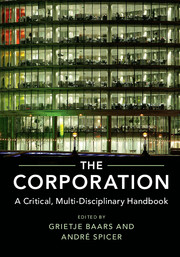Book contents
- Frontmatter
- Contents
- List of Contributors
- Acknowledgements
- Introduction: Why the Corporation?
- PART I DISCIPLINARY OVERVIEWS
- PART II INTERDISCIPLINARY THEMATIC CHAPTERS
- 1 The Evolution of the Corporate Form
- 2 The Multinational Corporate Group
- 3 The Financialization of the Corporation
- a The Financialization of the Corporation
- b Financialized Business Models and the Corporation
- c Transnational Corporations and the International Tax Haven and Offshore Finance System
- 4 Corporate Value Chains
- 5 Corporate Citizenship
- 6 The Corporation and Crime
- 7 The Corporation and Ideology
- 8 Corporation and Communities
- 9 Corporations and Resistance
- 10 Alternatives to the Corporation
- Index
- References
b - Financialized Business Models and the Corporation
from 3 - The Financialization of the Corporation
Published online by Cambridge University Press: 31 March 2017
- Frontmatter
- Contents
- List of Contributors
- Acknowledgements
- Introduction: Why the Corporation?
- PART I DISCIPLINARY OVERVIEWS
- PART II INTERDISCIPLINARY THEMATIC CHAPTERS
- 1 The Evolution of the Corporate Form
- 2 The Multinational Corporate Group
- 3 The Financialization of the Corporation
- a The Financialization of the Corporation
- b Financialized Business Models and the Corporation
- c Transnational Corporations and the International Tax Haven and Offshore Finance System
- 4 Corporate Value Chains
- 5 Corporate Citizenship
- 6 The Corporation and Crime
- 7 The Corporation and Ideology
- 8 Corporation and Communities
- 9 Corporations and Resistance
- 10 Alternatives to the Corporation
- Index
- References
Summary
This chapter uses the concept of business model to critically explore how financialization plays out at the level of the corporation. There has been increasing concern about the extent to which financialization has changed corporate behaviour: a mounting critical consensus argues that pressure to create value for shareholders has led to a disruption of business models with unfortunate outcomes for other stakeholders and an overly short-term orientation (e.g., Aglietta and Reberioux, 2005; Martin, 2011; Stout, 2012; Mintzberg, 2013). However, such analysis often lacks a clear view of the means by which value can be captured or extracted by particular groups of interests. These processes can vary in terms of specific dynamics inside the firm, and over networks or supply chains, and will reflect the distribution and exercise of power. This chapter addresses the question of how financialization affects corporate business models and the impact on stakeholder interests. It does this by arguing that, while financialization is observed as a general pressure for shareholder returns and a reprioritisation of stakeholder interests within the company, this plays out in many different ways and is governed by specific context. Such understanding is important because a critical business model analysis can help make sense of broader economic and social issues around inequality and instability.
After a brief review of the literature on the financialization of the corporation in section 1, the second section argues that the business model concept can be used within a political economy frame; this can be done by understanding that any corporate business model must ensure the conditions of financial viability while negotiating credibility in relation to certain groups of stakeholders. Specifically, a financialized business model will prioritize the interests of shareholders over other stakeholders. However, opportunities to realize or extract value are firm- and sector-specific, reflecting different kinds of leverage on operations, balance sheets or the state; thus consequences will not be straightforward, and the distributional effects on stakeholders will vary. The third section provides illustrations of how business models are variously levered on operations, balance sheets and the state to realize value, before offering a brief conclusion.
- Type
- Chapter
- Information
- The CorporationA Critical, Multi-Disciplinary Handbook, pp. 291 - 302Publisher: Cambridge University PressPrint publication year: 2017



